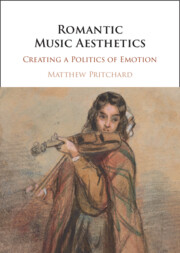Book contents
- Romantic Music Aesthetics
- Romantic Music Aesthetics
- Copyright page
- Contents
- Figures
- Music Examples
- Acknowledgements
- Note on Translation
- Introduction
- 1 Staging Sentimentality
- 2 The Legacy of Rousseau
- 3 The Composer as Genius
- 4 Idealist Aesthetics and the Music Critic
- 5 Picturing the Musical Absolute
- 6 Between Idealism and Realism I: The French Socialists
- 7 Between Idealism and Realism II: After Hegel
- 8 From Hanslick to the Twentieth Century
- Conclusion: The Fate of Feeling
- Bibliography
- Index
8 - From Hanslick to the Twentieth Century
Published online by Cambridge University Press: 22 November 2024
- Romantic Music Aesthetics
- Romantic Music Aesthetics
- Copyright page
- Contents
- Figures
- Music Examples
- Acknowledgements
- Note on Translation
- Introduction
- 1 Staging Sentimentality
- 2 The Legacy of Rousseau
- 3 The Composer as Genius
- 4 Idealist Aesthetics and the Music Critic
- 5 Picturing the Musical Absolute
- 6 Between Idealism and Realism I: The French Socialists
- 7 Between Idealism and Realism II: After Hegel
- 8 From Hanslick to the Twentieth Century
- Conclusion: The Fate of Feeling
- Bibliography
- Index
Summary
Eduard Hanslick’s On the Musically Beautiful (1854) constitutes the nemesis of the sentimental-Romantic ‘aesthetics of feeling’. It did not however completely expel emotion from music, as some thought, but from music aesthetics, framed as a new ‘science’ equally removed from historical and political context. This position differed radically from the Left Hegelian politics and Romantic aesthetics Hanslick had espoused a few years earlier. His change of heart was prompted by the revolution of 1848 and the subsequent growth of ‘Herbartianism’, an Austrian ‘state philosophy’ synthesized from the anti-Idealist thinkers J. F. Herbart and Bernard Bolzano. Hanslick’s own Herbartian programme had a direct impact on the Viennese tradition of musicology, and a more indirect influence over late Romantic thought on music, pushing toward a more analytical, ‘objective’ concept of music’s dynamic processes. By World War I, ‘energetic’ aesthetics had replaced Romantic emotions with an unsentimental vocabulary of forms, lines and energy-flows.
- Type
- Chapter
- Information
- Romantic Music AestheticsCreating a Politics of Emotion, pp. 198 - 218Publisher: Cambridge University PressPrint publication year: 2024

